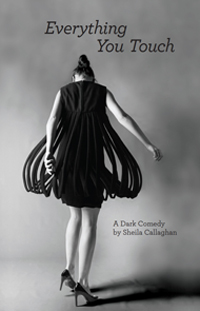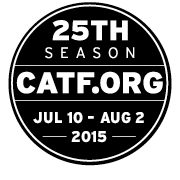Researched, interviewed and edited by Sharon J. Anderson, CATF Trustee/Professional Story Listener and Creative Director
CATF: In the interest of full disclosure, I don’t know a thing about fashion. A client once asked me if my shoes were Ferragamos. I replied, “No, they’re mine.” Would you recognize a pair of Ferragamos?
SC: No. I’m not a fashion maven. I’m pretty ignorant when it comes to labels. I know names, and I kind of stalk people on the Internet who have a fashion fetish. I’m sort of a voyeur of people who appreciate such things, but I am not an active appreciator myself. I don’t own one designer thing.
CATF: The following is from the opening to “Everything You Touch.” Victor, a ruthless fashion designer, is addressing a model: “When the model spits with rage, I want to feel that spittle. I want to smell your sweat. I want to taste your bile. I want my blood to boil. And I want to feel too overwhelmed after the experience to speak. This, to me, is the power of fashion.” Is this the power of fashion?
SC: No, it’s the power of art. Throughout the play, Victor sees what he does as a form of expression and a way of coping with a pretty devastating past rather than actually building clothes for people to put on their bodies. The play isn’t really about fashion even though fashion is the vehicle through which the play is communicated. It’s about family and art and what we compromise with one and what we sacrifice with the other.
CATF: TimeOut New York said that “Everything You Touch” has a “contagious nausea about women’s self-hatred.”
SC: Through the character of Jess, we are coping with our own self-loathing. Jess’s self-loathing is partially brought about by societal expectations of what makes an acceptable female and partially because of her upbringing at the hands of a fairly toxic parent who was suffering.
CATF: Your play has been described as “the struggle to find an identity that is more than skin deep.” Have you found your identify?
SC: I find one every day. Part of my job is to inhabit the psychic space of different individuals in order to accurately communicate them. I feel like if I’m not doing that with a whole heart and clear eyes, then I’m not necessarily doing my job right.
CATF: Anna Wintour, the editor of Vogue, said, “The notion that a contemporary woman must look mannish in order to be taken seriously as a seeker of power is frankly dismaying. This is America, not Saudi Arabia.”
SC: That last little bit is a little irritating, but I do think that there’s been a shift in women’s fashion regarding how people view power and femininity. Look at somebody like Hillary Clinton who continues to “masculate” herself because she wants to be either unthreatening or of the same echelon as her male counterparts. That was something in the 80s and 90s for women who wanted positions of power.
Nowadays, people like Marissa Mayer, the CEO of Yahoo, and other women CEOs wear designer clothes. They tend to bring in their femininity and are not necessarily fearful of being perceived as a threat because in the past, female sexuality and female power have been perceived as threatening. But it’s changing. Mayer is very feminine and has been a very powerful model for women who are also mothers in the workplace.
CATF: The designer Tom Ford has said: “I’m an equal opportunity objectifier. I’m just as happy to objectify men. The thing is, you can’t show male nudity in our culture in the way you can show female nudity. We’re very comfortable as a culture exploiting women, but not men. But I don’t think of it as exploitation either way.”
SC: It’s true. On my Showtime show, “Shameless,” we show male and female genitalia. It’s just rarer than breasts. We are more comfortable with female nudity because we are more used to seeing it, I think. We find the penis shocking because we still think of it as a weapon. We have the issues of rape in this country. It can be a dangerous thing. It’s easier to objectify a female body because it’s not necessarily associated with violence.
CATF: You have said that the theater that most people like, including you, “is this thoughtful, plodding, plot and plod build of character and story, until you’re full of the play.”
SC: Oh, I love plays like this, but I also think a lot of people love it to the exclusion of other types of plays. As a theater-going culture, we’re not comfortable with “outside-the-box” storytelling. We’re just not accustomed to seeing it. I like to be comfortable and amazed in a theater, but I also like to be uncomfortable and provoked. There’s less of a tolerance in our culture for that. But the more diverse and different the plays are, the more vibrant the field is.
CATF: You’ve said that you “like the feeling of having the play race out in front of you and you have to catch it.” That you like “speedy, flip-flop theater.”
SC: I do, and I like writing it, too.
CATF: One collaborator said that you have “one foot in the literary theater and the other in the avant-garde world. It’s really her love of both that makes her work so strong.”
SC: It also makes it a challenge. I tend to get mixed reviews. People like to walk out of the theater knowing exactly why they were there, and there’s nothing wrong with that. I prefer spending two hours in a theater being rattled and the next day asking myself, “What were my limitations in receiving the work?” rather than “What were the limitations in the work itself?” A work never exists in one acceptable realm. I like to walk away wondering about what the fuck I just saw and feeling a little angry about it. But sometimes I want to feel like I just ate a giant turkey dinner and all I have to do is just sit there and digest it and it’s gone out of my body the next day. Most mainstream theatergoers want the turkey dinner rather than the aggravation because there’s enough aggravation in people’s lives.
CATF: The poet John Ashbery said, “Most reckless things are beautiful in some way, and recklessness is what makes experimental art beautiful, just as religions are beautiful because of the strong possibilities they are founded on nothing.”
SC: To sit down and write art is a reckless impulse. You are trying to capture something unspoken, something completely inarticulate-able; and even when you’ve done it, it’s probably still incomprehensible in some way. There’s that impulse that you can’t necessarily contain with words or song or poetry or visuals, but you keep trying and trying and trying. That struggle is something that continually feels like trying to cope with a life force versus the desire to extinguish oneself to avoid feelings. That is something that feels human versus something that reaffirms what we already believe in the world that can pacify us . . . which is also valid. Religion is a valid way to cope with pain.
CATF: Anne Sexton said, “One can’t build picket fences to keep nightmares out.” There was a white picket fence around the house in “The United States of Tara” – a show you wrote for. . . .
SC: I think people build white picket fences to keep their hearts protected.
CATF: Gertrude Stein said, “Is it worse to be scared than to be bored, that is the question.”
SC: I would 100 percent rather be scared than bored, but then again you have to be held accountable for what you do when you are scared. There’s an irrationality that comes with a fight or flight response. Boredom allows you a little distance and a soft envelope within which you can make logical and measured choices.
CATF: You’ve said, “I’m drawn to anything where language comes alive. I don’t want language to feel strenuous. I like it to feel kind of magical with juxtapositions you wouldn’t expect popping out. Language works differently in space, much differently than it works on the page.” What do you mean by that?
SC: When you are reading poetry, you can have your own perception of it. You can absorb it, you can think about it, you can digest it, masticate it. You can go away from it, go back to it, read it over and over and over again. When you’re in a theater, you really can’t come and go. It’s just you and me. It almost has the effect of fireworks. The words are exploding in your face and then they are gone. I like fireworks.
CATF: You say that you write plays because, “I must. A yawping, bottomless cavern in my soul compels me thusly” and “because I am waiting for someone to tell me to stop.”
SC: I was being cheeky when I said that first part. The second part is what is really true – nobody has told me to stop. I don’t know what else to do. I’ve got all this bottomless shit in my head. I started teaching yoga recently to get out all that extra energy. I write to get out all the trauma.
CATF: You recently tweeted, “Please make sure my tombstone reads, “Brilliant but cancelled.”
SC: My impulse is to die before I fizzle. I know that sounds really dark, but maybe the brighter way of looking at that is that I hope I’m never irrelevant. A common art fear is that you stop understanding what makes people interested. I’d rather be brilliant but cancelled than mundane and long running.
CATF: Is there one question I could ask you that you would never answer?
SC: “Do you believe in God?”
CATF: Is there one question you’re dying for someone to ask you?
SC: “How do you remain so stunning?”
CATF: What’s unique about producing a play with the Contemporary American Theater Festival?
SC: We have access to Shepherd University, so we have many more resources at the ready. I’ve never done a show in rep before, so it’s interesting to create this kind of theater community. They’ve also been very generous with approaching artists with whom I might want to work.
CATF: Barbara Hammond ended a piece she wrote entitled, “How to Stay a New York Playwright” with this: “Now close your eyes again, envision a stage, and watch someone walk on from stage left. Get that pencil and write down what she says.” My last question to you: Close your eyes, someone is walking on from stage left. What is that person saying?
SC: “Oh fuck, wrong door!”

 Victor is a ruthless 1970s fashion designer and a devotee of the “beauty-is-pain” aesthetic. Esme, his glamorous lover and muse, is pushed aside when an ordinary Midwestern woman, Louella, inspires Victor to make his artistry accessible to the masses. A generation later, Jess, a self- loathing woman, wrestles her own family demons to find her way through the world of fashion that will not give her a second look. Flashing back and forth in time, Everything You Touch is a fierce, lushly written dark comedy that exposes the struggle to find an identity that is more than skin deep.
Victor is a ruthless 1970s fashion designer and a devotee of the “beauty-is-pain” aesthetic. Esme, his glamorous lover and muse, is pushed aside when an ordinary Midwestern woman, Louella, inspires Victor to make his artistry accessible to the masses. A generation later, Jess, a self- loathing woman, wrestles her own family demons to find her way through the world of fashion that will not give her a second look. Flashing back and forth in time, Everything You Touch is a fierce, lushly written dark comedy that exposes the struggle to find an identity that is more than skin deep.